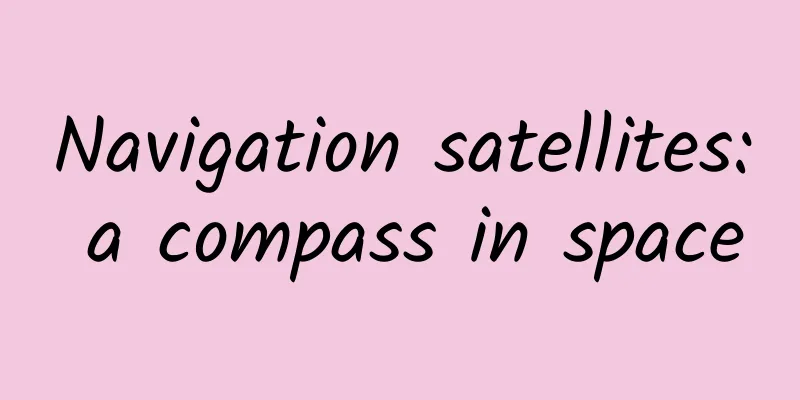Navigation satellites: a compass in space

|
Since ancient times, how to find the direction has been one of the most troublesome things for human beings. Whether in the land, forest, grassland or ocean, people often don't know where they are, where they came from and where they are going. Perhaps it is because of this that there are three famous philosophical questions: Who am I? Where do I come from, and where am I going? Early navigation systems With the deepening of human astronomical observation, using stars for navigation has gradually become a common method. Especially on the vast ocean, people can hardly see anything except the stars and the dazzling sun. However, astronomical navigation also has its own shortcomings. The most fatal problem is the lack of accuracy. In the sailing age, ships sailed very slowly, and accuracy became a matter of life and death. Because if you deviate by a few degrees and fail to find the direction of the continent, or even just miss the port for a few days, the fresh water on the ship will run out and the food will run out, which may result in death. Therefore, after the emergence of aerospace technology, using artificial satellites to provide navigation and positioning services to people within the earth's atmosphere has become a strong demand. The world's first satellite navigation system that was actually put into use was the Transit system, which used Doppler navigation technology. People are familiar with the Doppler effect, that is, when people move in the direction of electromagnetic waves, they will feel that the frequency has increased and the wavelength has decreased; conversely, the frequency has decreased and the wavelength has increased. The Transit system has been successful in engineering, but there are still many shortcomings, mainly low positioning accuracy, long positioning time, and large equipment size, which can only be used on larger ships. Of course, in an era when radio communication technology had been invented, the low positioning accuracy of the system would not necessarily lead to the death of the crew members due to hunger and thirst, but it still had a great impact on navigation. In particular, the meridian system was difficult to use for navigation of vehicles and aircraft. People still hoped that there would be a more accurate and convenient means to improve the accuracy and speed of navigation and improve the efficiency of navigation. Principles of modern navigation technology Generally speaking, only extreme military needs will promote great breakthroughs in engineering, and the same is true for satellite navigation technology. In the 1970s, in order to solve the navigation problem of ballistic missile nuclear submarines, the US Navy was determined to develop a new generation of satellite navigation system covering the world, which gave birth to the famous GPS system. The biggest difference between the GPS system and the meridian system is that the navigation code is used to determine the specific location of the platform. Simply put, a long string of numbers is converted into radio waves and transmitted. This radio wave contains the satellite's identity information and time information. The receiver uses this information to calculate the distance from the satellite. The principle is this: the propagation of electromagnetic waves also takes time. Although the navigation message sent from the GPS satellite 20,200 kilometers away from the earth's surface can reach the earth in a flash, it usually takes no more than 0.1 seconds. However, the high-precision electronic system can accurately calculate how far the radio waves have traveled, accurate to meters. Then according to the basic principles of geometry, as long as the navigation messages from three satellites are obtained, the specific location of the receiver can be calculated. This is the basic principle of GPS navigation. The Russian GLONASS system, the European Galileo system and the Chinese Beidou system that were subsequently established all use the same principle. Of course, due to the existence of various electromagnetic interference factors, it is difficult to get the exact position from the calculation results of the three satellite signals. The receiver generally needs four satellites or even more to calculate the exact position. However, the advantage of GPS is that the positioning speed is very fast. As long as the calculation speed of the receiver is fast enough, real-time positioning can be achieved. This is of great significance for high-speed moving objects, such as cars, high-speed railways, airplanes, missiles, and even low-orbit satellites, which can all be located using GPS. Airplanes and low-orbit satellites fly at relatively high altitudes, so they can often receive signals from 12 GPS satellites at the same time, providing better conditions for navigation. Navigation system changes life The application of the GPS system has also made relevant Chinese departments fully aware of the necessity of a global satellite navigation system. After more than 20 years of hard work, China has gradually established its own Beidou satellite navigation system from a regional system to a global system, which has also become one of the world's four major satellite navigation systems. Together with the navigation systems of the United States, Russia and Europe, there are currently more than 100 navigation satellites in space, transmitting navigation messages to the ground day and night. This also brings people another way of thinking: If the services of these four constellations are integrated together, can users get a better experience? This is the so-called compatibility and interoperability. At present, the four major navigation systems have achieved compatibility and interoperability. The biggest benefit it brings is that at any time, the user can see far more than 4 navigation satellites, and the navigation effect that can be achieved is of course better. Almost at any time, we can get our precise location by taking out our mobile phones. The introduction of satellite navigation has brought about tremendous changes in people's lives. Combined with electronic maps, it has realized personal navigation services, making it less likely to get lost whether walking or driving. Combined with mobile networks, it has also realized remote monitoring. The children's watches on children's wrists are located by navigation satellites. Navigation also solves the navigation problem of unmanned systems, making long-distance navigation of drones, unmanned vehicles, and unmanned ships possible. During the epidemic, many people had to rely on couriers to solve shopping and eating problems. With satellite navigation, couriers can accurately and promptly find the location of buyers. Satellite navigation has also had a huge impact on warfare. Targets that used to require indiscriminate bombing can now be destroyed with just one or two missiles. The US GPS-guided artillery shells even deliberately have to be loaded with less explosives to reduce their lethality, because they are extremely accurate and can accurately hit the target's head. A smaller power can also ensure destruction and avoid accidentally injuring others and being criticized by public opinion. Of course, with the outbreak of the Russia-Ukraine conflict, the cooperation between the GPS system and the GLONASS system was artificially interrupted. However, for the Chinese, with the Beidou navigation system, our navigation services have been basically guaranteed. |
<<: Can soda water adjust the body's acid-base balance? Rumors on the June "Science Rumors List"
>>: Typhoon Siam is approaching! It will make landfall today
Recommend
#千万IP创科普# A girl met online while playing games and was defrauded of more than 20,000 yuan! Be careful of these scams targeting students!
It's winter vacation Students have a long-awa...
What kind of phenomena did the "eyewitnesses" discover before the Wenchuan earthquake? Are earthquakes really unpredictable?
Hello everyone, today I, the editor from Sichuan,...
Warning! =͟͟͞10=͟͟͞͞Level=͟͟͞͞Thunder=͟͟͞͞Storm=͟͟͞͞Strong=͟͟͞͞wind will affect 9 provinces! How to deal with severe convective weather?
Heavy rainfall will continue today and tomorrow (...
Do you use a smartphone?
Market research firm Juniper Research (hereinafte...
Mr. Huang's exclusive career tips: job hunting
Course Catalog: ├──【Job Hunting Class·Must Listen...
Beijing autonomous driving road test report released: Baidu Apollo, the leading player in China and abroad, accounts for 91% of the total mileage
On April 1, the "Beijing Autonomous Driving ...
Exclusive interview with Zeng Jian, senior web front-end engineer at Tencent: Node.js or H5?
With the continuous enrichment of mobile Internet...
Why do airplanes fly? The secret lies in their wings
"It's so fast that it's about to fly...
Douyin operates traffic, increases fans and conversions!
I believe that for the vast majority of companies...
The World Health Organization announced that it will be completely eradicated by the end of 2023! All about its files and "crimes" are explained at once
Image from: freepik.com Recently, the World Healt...
How to use coupons for promotion, here are 4 tips for you!
Coupons are the most commonly used tool in our op...
Buyout or subscription? Apple is worried about the future of the App Store
[[240568]] In the past, when I bought apps in the...
Two weeks, use Flutter to build an APP
Preface Flutter is a cross-platform solution laun...
The new Model S has no gear lever. Musk: The new car can guess where you are going.
The redesigned, high-tech cabins of the new Tesla...
Remember the "Ozone Hole"? It healed quietly!
When we were young, we often saw news reports abo...









